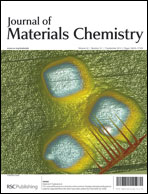Bimodally integrated anode functional layer for lower temperature solid oxide fuel cells
Abstract
Here we demonstrated a simple low-cost approach to dramatically increase the power density of solid oxide fuel cells (SOFCs) using an improved anode functional layer (AFL) structure. By infiltrating a very small amount (∼2 wt%) of Ni and Gd0.1Ce0.9O1.95(GDC) precursor solution into a submicron-sized, colloidally deposited AFL, a high power density cost-effective bimodally integrated AFL (BI-AFL) was produced. Microstructural analysis of this BI-AFL revealed that the superimposed ultra-fine features surrounding a submicron Ni–GDC particulate structure remained even after high temperature sintering. Applying this BI-AFL on an anode-supported SOFC yielded a maximum power density (MPD) of ∼1.2 W cm−2 at 600 °C, a ∼3× increase compared to SOFC without an AFL. Electrochemical impedance results showed a striking decrease in both ohmic and non-ohmic electrode area specific resistances (ASR) compared to SOFCs with either no AFL or a conventional AFL. The effect of the BI-AFL structure on improving SOFC performance was even greater at lower temperature. These results indicate that a network structure with bimodal particle size distribution in the AFL dramatically increased triple phase boundary (TPB) length and enhanced the interfacial contact between anode and electrolyte.


 Please wait while we load your content...
Please wait while we load your content...